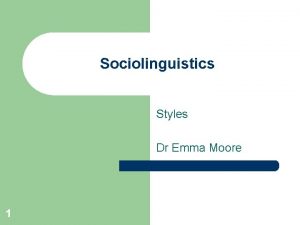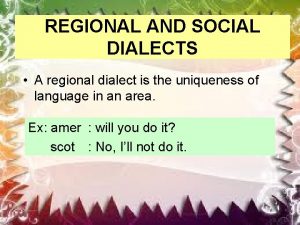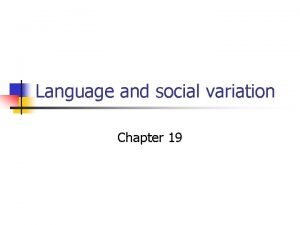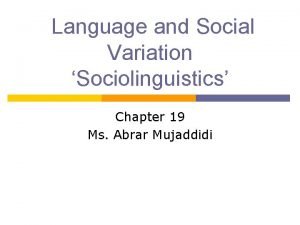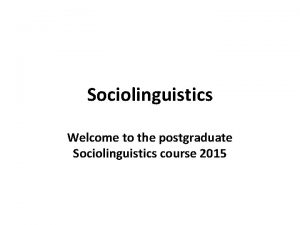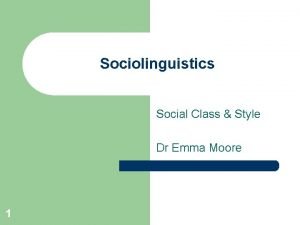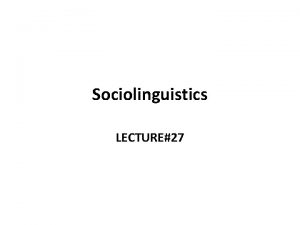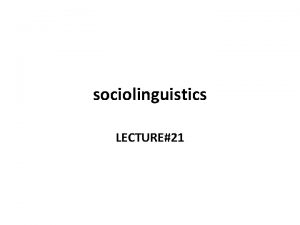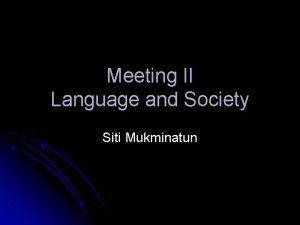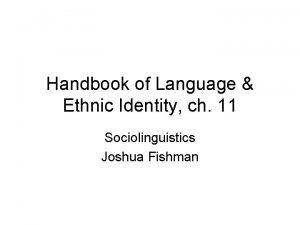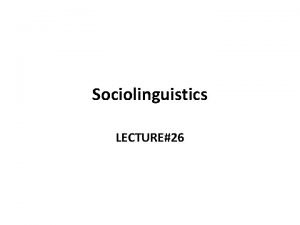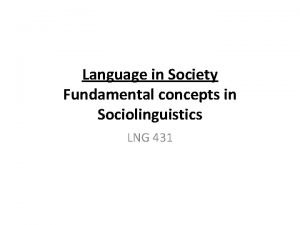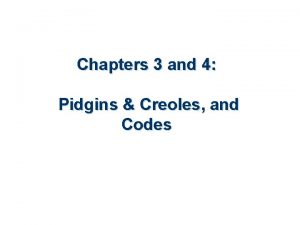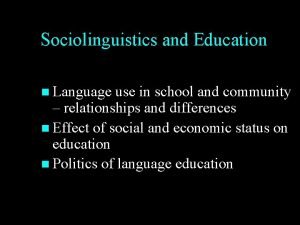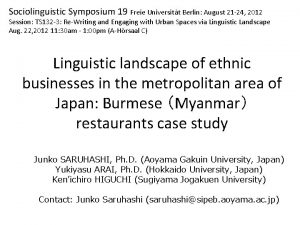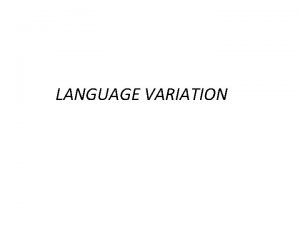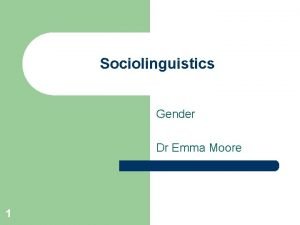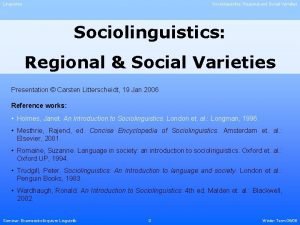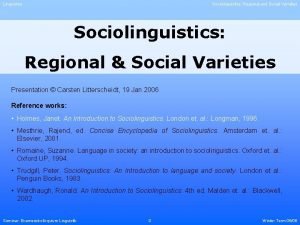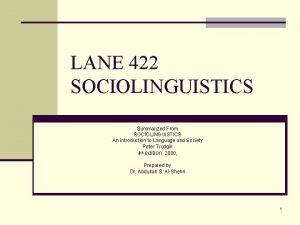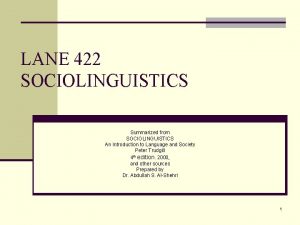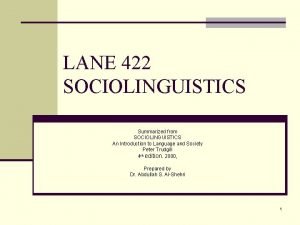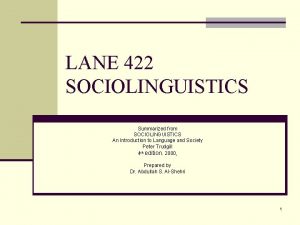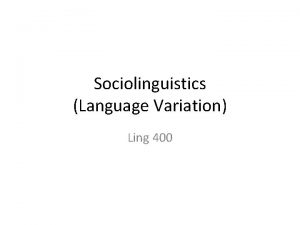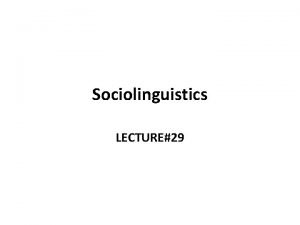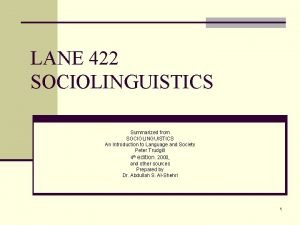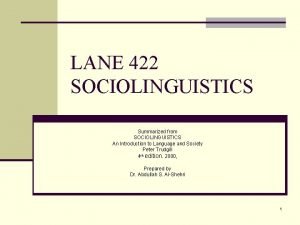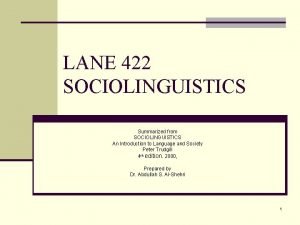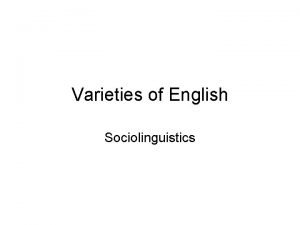Sociolinguistics Social Groups Social Networks Dr Emma Moore


























- Slides: 26

Sociolinguistics Social Groups & Social Networks Dr Emma Moore 1

Contents l l 2 What are the limitations of survey studies? Why study local groups? How can we study local groups? What have social network/community of practice studies told us about sociolinguistic variation?

Limitations of surveys l Do surveys make assumptions about the community and its structure? – l Do large scale studies make assumptions about what speakers think? – 3 What does it mean to talk about social class? Do all speakers view the same linguistic variant in the same way?

Labov’s speech community l “The speech community is not defined by any marked agreement in the use of language elements, so much as by participation in a set of shared norms; these norms may be observed in overt types of evaluative behaviour, and by the uniformity of abstract patterns of variation which are invariant in respect to particular levels of usage” (Labov 1972: 120). – – 4 All speakers share the same norms Uniformity in style shifting behaviour

Challenging abstract social categories: local definitions of class l Rickford (1986) – – Cane Walk, village in Guyana Three main social groups: l l l – l 5 The senior staff The estate class The working class All three groups bound by ethnicity & historical ties (19 C semi-forced migration from India) Differences in life chances based on local definitions of class

Explaining language use l Language use: – l Analysingular pronoun use – – l WC: 18% St. E Estate class: 83% St. E Why? – – 6 Guyanese Creole Standard English Can we say all social classes are adhering to the same norms? Estate class: St. E = getting ahead WC: no chance to get ahead; Creole = social solidarity, militancy

Challenging abstract social categories: social groups l Cheshire (1982) – Reading adventure playgrounds l – Examining morphosyntactic variation l – E. g. use of nonstandard has, was etc. Considered style shifting l l 7 Groups of ‘delinquent’ children (WC) Language used with peers Language used with the teacher in school

Adhering to different norms Use of nonstandard present tense forms Vernacular style School style Noddy 81% 78% Kitty 46% 33% Barney 32% 54% – Inconsistent style-shifting l l l 8 Noddy: hated school, disliked teacher Kitty: regular school attender Barney: hated school, disliked teacher Boys do not adhere to ‘community’ norms of evaluation, but to ‘vernacular culture’ norms

Vernacular speakers & vernacular norms? l l Are standard variants always the most “prestigious”? Social psychological studies investigating responses to different language varieties – Giles and Powesland (1975): l l – 9 RP = “competence” Vernacular = “personal integrity”; “social attractiveness” Revealing the positive value of vernacular varieties

Understanding how forms gain value l Bourdieu (1977): The linguistic market – The value of a linguistic variety is determined by the status of those who use that variety, in the marketplace in which it is used Standard language Spoken by high status speakers 10 Standard language itself assigned high status

Understanding how forms gain value l Woolard (1985): There is more than one linguistic market – Vernacular varieties are valued in vernacular settings (the vernacular market) Vernacular language Spoken by speakers in local communities (loyalty, integrity, friendship) 11 Vernacular language itself assigned status as symbolic of local attributes

Competing norms l l Vernacular varieties = low mainstream status, unattractive Vernacular varieties = high local status, attractive – How do we understand the social function of vernacular forms? l 12 By accessing local communities where the forms are meaningful Looking at local connections NOT abstract categories

Modelling local communities: Social networks Social network: refers to the social ties which link people to one another l Network density l Multiplexity Work network Kinship network 13

Milroy’s (1980) study of Belfast l Three WC Belfast communities – l Ballymacarrett, Hammer & Clonard Speakers classified by their social networks l Assessing network strength scores for speakers Leisure activities – Employment – Knowledge of other community members – 14

Milroy’s (1980) study of Belfast l Linguistic variables: – Local vs. incoming prestige forms l E. g. (a)-backing in words like bad – – l Results – – 15 /a/ (standard pronunciation) /ɔə/ (vernacular change in progress) Men tended to use more vernacular variants than women in Ballymacarratt and Hammer Young women had higher use of particular vernacular variants in Clonard

Network ties and language use l Ballymacarratt and Hammer – Men had stronger network ties l l l Clonard – Young women had higher network strength scores l 16 Employment Roles in the community/visibility Employment (loss of linen industry)

Significance of Milroy (1980) l The importance of LOCAL relationships to the use of language – l Dense, multiplex networks & VERNACULAR norms Building on earlier work: – – Provides more information about the community being studied Allows us to explain language behaviour in relation to local social factors l 17 Not just gender or class, but social network

Modelling local communities: Communities of Practice Community of Practice (Cof. P): “an aggregate of people who come together around mutual engagement in an endeavor” (Eckert and Mc. Connell-Ginet 1992: 464). 18 “The people at the Jones’s breakfast table, in Mrs. Constock’s Latin class, or in Ivan’s garage band get together fairly regularly to engage in an enterprise. Whether the enterprise is being a family, learning (or not learning) Latin, or playing music, by virtue of engaging over time in that endeavour, the participants in each of these groups develop ways of doing things together. They develop activities and ways of engaging in those activities, they develop common knowledge and beliefs, ways of relating to each other, ways of talking – in short, practices. Such a group is what Jean Lave and Etienne Wenger (1991) have termed a community of practice” (Eckert and Mc. Connell-Ginet 2003: 57).

How is a Cof. P different to a social network? l l Social networks: who is connected to who in a community Communities of Practice: who shares social practice with who in a community – – 19 Not just about connectivity, but quality of connectivity Studying Cof. Ps require ethnography

Eckert’s (2000) study of Detroit l High school community in Detroit, US – l Speakers classified by their Cof. P membership – 20 Two years of ethnographic participant observation Practices: territory, clothing, substance use, language

Eckert (2000): Jocks and Burnouts l Two oppositional Cof. Ps: – – l Variables studied: – 21 Jocks: institutionally-orientated Burnouts: rebellious, anti-school Six phonetic variables (vowels); one syntactic variable (Negative concord)

Variable distribution and Co. Ps l Distribution of linguistic variants best explained by the Jock-Burnout split – Social class relevant BUT not as strong an explanation as practice …and especially interesting findings with gender 22

Cof. Ps and gender Raising of (ay): right /aɪ/ to /ɔɪ/ 23 Burnout girls > Burnout boys > Jock girls

Significance of Eckert (2000) l The importance of LOCAL relationships to the use of language – l Cof. P membership (i. e. local social practice) constrains linguistic behaviour more than abstract social categories Building on earlier work: – – Provides more information about the community being studied Allows us to explain language behaviour better l 24 Not just gender or class, but how local speakers LIVE gender & class

Summing up… l Early variationist studies provide a broad view of sociolinguistic variation – BUT to explain variation, we sometimes need closer analysis of communities l l 25 Prevents overgeneralisation Allows us to explore competing norms Gets us closer to the precise social correlates of variation The social network & the Cof. P approach provide frameworks for more local analyses

Reading and selected references l l Cheshire, Jenny (1982) Variation in an English Dialect: A Sociolinguistic Study. Cambridge: Cambridge University Press. Eckert, Penelope (2000) Linguistic Variation as Social Practice: The Linguistic Construction of Identity at Belten High. Oxford: Blackwell. Milroy, Lesley (1980) Language and Social Networks. Oxford: Basil Blackwell. Rickford, John (1986) “The need for new approaches to social class analysis in sociolinguistics”. Language and Communication 6: 215 -221. Required reading: Meyerhoff (2006: Chapter 9) 26
 Dr emma moore
Dr emma moore Caste dialect
Caste dialect Social linguistics
Social linguistics Social variations
Social variations Virtual circuits and datagram networks
Virtual circuits and datagram networks Basestore iptv
Basestore iptv How are ethnic groups and religious groups related
How are ethnic groups and religious groups related Variationist sociolinguistics
Variationist sociolinguistics Sociolinguistics topics for presentation
Sociolinguistics topics for presentation Variationist sociolinguistics
Variationist sociolinguistics Language and dialect in sociolinguistics
Language and dialect in sociolinguistics Sociolinguistic
Sociolinguistic Sociolinguistics variation
Sociolinguistics variation What is sociolinguistics
What is sociolinguistics Status scale in sociolinguistics
Status scale in sociolinguistics Ethnicity in sociolinguistics
Ethnicity in sociolinguistics Code switching in sociolinguistics
Code switching in sociolinguistics Register (sociolinguistics)
Register (sociolinguistics) Concepts of sociolinguistics
Concepts of sociolinguistics Sociolinguistics slideshare
Sociolinguistics slideshare What is pidgin
What is pidgin Sociolinguistics and education
Sociolinguistics and education Malihka burmese restaurant
Malihka burmese restaurant What is regional variation in sociolinguistics
What is regional variation in sociolinguistics Origin of sociolinguistics
Origin of sociolinguistics Types of sociolinguistics
Types of sociolinguistics Power dynamics of standard language as school language
Power dynamics of standard language as school language
